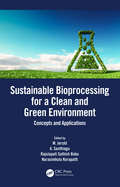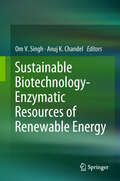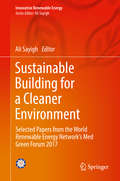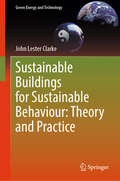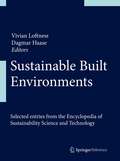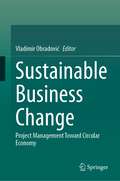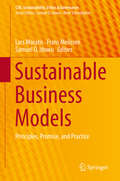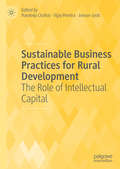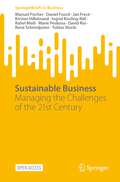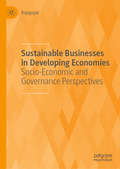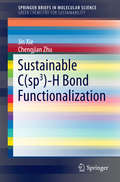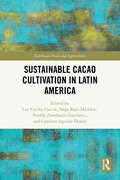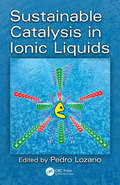- Table View
- List View
Sustainable Bioenergy Production - An Integrated Approach
by Martin Kappas Hans Ruppert Jens IbendorfThis book focuses primarily on the advantages and implications of sustainable bioenergy production in terms of ensuring a more sustainable world despite its growing energy demands. It addresses a new concept that focuses on the interactions between different uses of agricultural land (for example, agriculture for food, forage or energy and nature conservation) and their ecological, economic and societal impacts. This research concept provides new insights into the competition for resources and the synergies between different land uses. This book seeks to improve people's understanding of bioenergy's potentials for the future. It will be of interest not only to those involved in sustainable energy, but also to environmental planners, agriculture and soil specialists, and environmental policy-makers.
Sustainable Bioenergy and Bioproducts
by Robert C. Brown J. Hans Van Leeuwen Kasthurirangan GopalakrishnanSustainable Bioenergy and Bioproducts considers the recent technological innovations and emerging concepts in biobased energy production and coproducts utilization. Each chapter in this book has been carefully selected and contributed by experts in the field to provide a good understanding of the various challenges and opportunities associated with sustainable production of biofuel. Sustainable Bioenergy and Bioproducts covers a broad and detailed range of topics including: production capacity of hydrocarbons in the plant kingdom, algae, and microbes; biomass pretreatment for biofuel production; microbial fuel cells; sustainable use of biofuel co-products; bioeconomy and transportation infrastructure impacts and assessment of environmental risks and the life cycle of biofuels. Researchers, practitioners, undergraduate and graduate students engaged in the study of biorenewables, and members of the well-informed public will find Sustainable Bioenergy and Bioproducts to be a useful and comprehensive research tool, describing the state of the art and recent developments in this field.
Sustainable Biopolymers and Composites for Biomedical Applications (Biomaterials, Bioengineering and Sustainability #5)
by Maurice N. Collins Mario CulebrasThis book aims to summarize progress in the development of sustainable routes for the production of biopolymers and biocomposites for advanced biomedical engineering and pharmaceutical applications. The book will concentrate on the latest developments in the emerging field of lignin valorization which is essentially a waste material from the paper and pulp industry. The first part of the book will provide the reader with a general overview of the current trends in biopolymers for bioengineering and why there is such a large requirement for sustainable practices in the biomedical field. We will set this within the context of the UN sustainable development goals and the urgent need to move away from fossil-based materials to alleviate climate change. The second part of the book will focus on areas with the greatest potential for the deployment of sustainable polymers in medicine examples include sensors, tissue engineering, drug encapsulation, hydrogels etc. The final section of the book will include a life cycle analysis (LCA0 and a technoeconomic assessment of the transition from fossil to sustainable sources of raw materials.
Sustainable Bioprocessing for a Clean and Green Environment: Concepts and Applications
by M. Jerold A. Santhiagu Rajulapati Sathish Babu Narasimhulu KorapattiSustainable Bioprocessing for a Clean and Green Environment: Concepts and Applications highlights the importance of waste to health in which waste is safely converted to value-added products via bioprocess technologies. Providing fundamental concepts and applications, this book also offers readers the methodology behind the operation of a variety of biological processes used in developing valuable products from waste. Features: Discusses synthesis and use of environmentally friendly biobased materials, such as biopolymer films and biobased plasticizers Highlights nanotechnology applications in the treatment of pollution and emphasizes the synthesis of biogenic nanomaterials for environmental remediation Describes the use of biosurfactants and emerging algal technologies, such as applications of microalgae in nutraceuticals and biofuel production Details delignification for lignocellulosic biomass This interdisciplinary book offers researchers and practitioners in chemical engineering, environmental engineering, and related fields a broad perspective on fundamentals, technologies, and environmental applications of sustainable bioprocessing.
Sustainable Biotechnology
by Om V. Singh Steven P. HarveySustainable Biotechnology; Sources of Renewable Energy draws on the vast body of knowledge about renewable resources for biofuel research, with the aim to bridge the technology gap and focus on critical aspects of lignocellulosic biomolecules and the respective mechanisms regulating their bioconversion to liquid fuels and other value-added products. This book is a collection of outstanding research reports and reviews elucidating several broad-ranging areas of progress and challenges in the utilization of sustainable resources of renewable energy, especially in biofuels.
Sustainable Biotechnology and Environmental Protection: A Four-pronged Strategy (Green Energy and Technology)
by Yelizaveta Chernysh Viktoriia Chubur Hynek RoubíkThis book explores the critical role of biotechnology in addressing today’s most pressing environmental challenges. The book presents a comprehensive four-pronged strategy focused on minimizing waste, reducing toxicity, improving waste disposal, and transforming waste into valuable resources. With a special emphasis on sustainable bioeconomy approaches, it highlights the potential of biotechnological innovations in urban development and environmental protection. The book also addresses the impact of policies and regulations, offering a holistic view of how biotechnology can pave the way for a safer and more sustainable future.
Sustainable Biotechnology- Enzymatic Resources of Renewable Energy
by Om V. Singh Anuj K. ChandelNature offers abundant renewable resources that can be used to partially replace fossil fuels and commodity chemicals but issues of cost, technology readiness levels, and compatibility with existing distribution networks remain huge challenges. Cellulosic ethanol and biodiesel are the most immediately obvious target fuels, with hydrogen, methane and butanol as other potentially viable products. This book continues to bridge the technology gap and focus on critical aspects of lignocellulosic biomolecules and the respective mechanisms regulating their bioconversion to liquid fuels into energy and value-added products of industrial significance. This book is a collection of reviews elucidating several broad-ranging areas of progress and challenges in the utilization of sustainable resources of renewable energy, especially in biofuels. This book comes just at a time when government and industries are accelerating their efforts in the exploration of alternative energy resources, with expectations of the establishment of long-term sustainable alternatives to petroleum-based liquid fuels. Apart from liquid fuel this book also emphasizes the use of sustainable resources for value-added products, which may help in revitalizing the biotechnology industry at a broader scale. This book also provides a comprehensive review of basic literature and advance research methodologies to graduate students studying environmental microbiology, chemical engineering, bio-economy and microbial biotechnology.
Sustainable Blended Learning in STEM Education for Students with Additional Needs (Contributions to Environmental Sciences & Innovative Business Technology)
by Anand Nayyar Adarsh Kumar Neelu Jyothi AhujaThis book comprehensively covers sustainable blended learning approach in each of the STEM (science, technology, engineering and mathematics) disciplines. The book also includes the compilation of detailed concepts of blended learning ranging from definition, need, features, models, advantages and disadvantages and comparisons with traditional face-to-face learning. Sustainable blended learning in K-12 education has an immense role as foundation to learning for students in their early education. Fostering creativity and inculcating problem solving and critical thinking skills are the integral aspect of STEM education, which encourages students to pursue them to for their future careers. This book presents recent practices taken by experts at various levels to promote education in STEM. Furthermore, impact over teacher–student relationships is analyzed. Lastly, sustainable frameworks, strategies and implementation to incorporate students with additional needs are explored.
Sustainable Building Materials and Construction: Select Proceedings of ICSBMC 2021 (Lecture Notes in Civil Engineering #222)
by Vasant Matsagar B. Kondraivendhan C. D. ModheraThis book presents the select proceedings of the International Conference on Sustainable Building Materials and Construction (ICSBMC 2021), and examines a range of durable, energy-efficient, advance construction and building materials produced from industrial wastes and byproducts. The topics covered include advanced construction materials, durability of concrete structures, waste utilization, repair & rehabilitation of concrete structures, structural analysis & design, composites, nanomaterials and smart materials in seismic engineering. The book also discusses various properties and performance attributes of modern-age concretes including their strength, durability, workability, and carbon footprint. This book will be a precious reference for beginners, researchers, and professionals interested in sustainable construction and allied fields.
Sustainable Building Performance: Towards a Greener India
by J. VijayalaxmiThis book highlights the evaluation and assessment of various aspects of sustainable buildings to achieve a greener future. India, at the 26th session of the United Nations Framework Convention on Climate Change (COP 26) in November 2021, announced its target to achieve net zero by 2070. Being an emerging economy, the number of buildings required is expected to grow exponentially. Hence, there is a need for a pragmatic and realistic path to reach the committed goal of reaching net zero. To participate in a global transition to clean, low-carbon energy systems, which aligns with Sustainable Development Goal (SDG) 11 (Sustainable Cities and Communities) and Climate Action (SDG 13), it is important to research cooling strategies for a tropical country like India. The India Cooling Action Plan clearly acknowledges the deep connection between SDGs, especially SDG 13. Passive cooling strategies require a micro-level understanding of the impact of building materials on the thermal performance of buildings. To contribute to the global transition to clean, low-carbon energy systems, it is essential to assess India's energy retrofit policies, the use of low-carbon building materials, energy-efficient building design to enhance passive cooling, ways to mitigate outdoor heat, and learnings from vernacular architecture and biophilic building design. This book explores how viable solutions such as these could address some of India's most pressing challenges, including energy efficiency, climate resilience, and environmental sustainability, contributing to India's progress towards SDG 3 (Good Health and Well-being), SDG 7 (Affordable and Clean Energy), SDG 9 (Industry, Innovation, and Infrastructure), and SDG 13. The research papers presented in this book are the result of systematic research conducted after identifying a research gap through the latest review of literature. They present new knowledge that can aid in making performance-based design decisions. All these aspects are analyzed using real-time data obtained through field studies. The book is a valuable resource for professionals and researchers working in energy efficiency and sustainable buildings.
Sustainable Building for a Cleaner Environment: Selected Papers from the World Renewable Energy Network's Med Green Forum 2017 (Innovative Renewable Energy)
by Ali SayighThis book contains selected papers presented during the bi-annual World Renewable Energy Network’s Med Green Forum aimed at the international community as well as Mediterranean countries. This forum highlights the importance of growing renewable energy applications in two main sectors: Electricity Generation and the Sustainable Building Sector. In-depth chapters highlight the most current research and technological breakthroughs, covering a broad range of renewable energy technologies and applications in all sectors – for electricity production, heating and cooling, agricultural applications, water desalination, industrial applications and for the transport sectors.
Sustainable Buildings and Structures: Proceedings of the 1st International Conference on Sustainable Buildings and Structures (Suzhou, P.R. China, 29 October - 1 November 2015)
by Bing Chen Jun Xia Stephen P. WilkinsonSustainable Buildings and Structures collects the contributions presented at the 1st International Conference on Sustainable Buildings and Structures (Suzhou, China, 29 October-1 November 2016). The book aims to share thoughts and ideas on sustainable approaches to urban planning, engineering design and construction. The topics discussed include:-
Sustainable Buildings for Sustainable Behaviour: Theory and Practice (Green Energy and Technology)
by John Lester ClarkeThis book is about where theory meets practice in the realm of sustainable architecture. The book reveals how to create buildings that not only minimize environmental impact but also help shape sustainable behaviour. Including a literature review, comprehensive online surveys, and analysis of real projects, the book presents a narrative that blends theory with tangible examples. It includes illustrated case studies that breathe life into five exemplary sustainable buildings, showcasing their impact. The book demonstrates the potential of architecture to realise a sustainable future. It shows how construction can help build a more sustainable world.
Sustainable Built Environments
by Vivian Loftness Dagmar HaaseSustainable design is a collective process whereby the built environment achieves unprecedented levels of ecological balance through new and retrofit construction, with the goal of long-term viability and humanization of architecture. Focusing on the environmental context, sustainable design merges the natural, minimum resource conditioning solutions of the past (daylight, solar heat, and natural ventilation) with the innovative technologies of the present. The desired result is an integrated "intelligent" system that supports individual control with expert negotiation for resource consciousness. International experts in the field address the fundamental questions of sustainable design and landscape management: How should the sustainability of landscapes and buildings be evaluated? Which targets have to be set and which thresholds should not be exceeded? What forms of planning and governance structures exist and to what extent do they further the goals of sustainability? Gathering 30 peer-reviewed entries from the Encyclopedia of Sustainability Science and Technology, Sustainable Built Environments provides comprehensive, multidisciplinary coverage of these issues and other aspects of sustainable building and landscape design.
Sustainable Business Change: Project Management Toward Circular Economy
by Vladimir ObradovićThis volume aims to explore project management contributions to sustainable business change based on renewability, reuse, and repair as well as the effect of circular economy business solutions on project management in terms of the management approach, governance, and leadership. The main aim of integrating project management with a circular business paradigm is not only to learn how project management can contribute to achieving circular economy principles, but also to understand the impact of business needs on project management. By understanding these needs, recommendations can be developed and promoted among different stakeholders such as governments, financial institutions, and education institutions with the goal of supporting and assisting project management to drive sustainable business change. This approach will enable readers to assess how project management professions can support a shift toward sustainable business. The primary audience of this work is management scholars, educators, researchers, and students. Scholars, government representatives, financial institutions, management educators, start-up companies, innovative entrepreneurs, and all others who use the circular economy to support sustainable development can also find much of use in this book.
Sustainable Business Models: Principles, Promise, and Practice (CSR, Sustainability, Ethics & Governance)
by Samuel O. Idowu Frans Melissen Lars MoratisThis book provides a rich overview and takes a closer look at the current state of theory and practice in the field of sustainable business models. The chapters in this book examine and analyze existing and new approaches towards sustainable business models and showcase the implementation of sustainable business through both quantitative and qualitative studies, including several case studies and many practical examples. It approaches these issues from the standpoints of diverse business disciplines to yield new insights and ideas that are relevant from both an academic and professional perspective. In its essence, the book examines how firms’ value creation processes can be driven by sustainability and social responsibility and how this impacts business and society. Readers will find a range of sustainable business models that have been employed and are being pioneered in various industries around the globe – which are thoroughly investigated and discussed, and put into a comprehensive conceptual framework.
Sustainable Business Practices for Rural Development: The Role of Intellectual Capital
by Vijay Pereira Hardeep Chahal Jeevan JyotiThe book includes empirical research papers and case studies embracing human capital, relational capital and structural capital in context to services and manufacturing sectors. It will highlight on the sustainable business practices manifested in the work culture, values and beliefs in context to rural regions. From a learning and managerial perspective, the book will identify effective business practices in varied service and manufacturing sectors significant for sustaining business performance and competitive advantage.
Sustainable Business: Managing the Challenges of the 21st Century (SpringerBriefs in Business)
by René Schmidpeter Manuel Fischer David Risi Ingrid Kissling-Näf Daniel Foord Jan Frecè Kirsten Hillebrand Rahel Meili Marie Peskova Tobias StuckiThis open access book is a compact guide to the development of sustainable business, which has become the central concept in discussions about the future development of humanity and planet earth. It provides basic terminology and concepts on sustainable business and offers insights into a new management paradigm that integrates social and environmental dimensions into business models, strategies, and operations. New business concepts such as the donut economy, the circular economy, social innovation and sustainable leadership are introduced and the book outlines how they influence the way we run businesses today and in the future. This book lays the foundation for new management thinking in business and academia, making it a essential reader for professionals and students alike.
Sustainable Businesses in Developing Economies: Socio-Economic and Governance Perspectives
by RajagopalTrends in cleaner business decisions have resulted in sustainable business models involving society, stakeholders, and consumers. Sustainable choices of companies create competitive differentiations that enable consumers to weigh social values and shift loyalties in the competitive marketplace. This book focuses on sustainability as the pivot of marketing and argues that commitment to sustainability in business not only equips companies to have greater social impact but also inspires an emotional response in consumers that aids companies in growing their image, brands, and socio-political reputations. Exploring topics such as the circular economy, sustainable logistics, eco-innovation, conscious consumption, and social entrepreneurship, the chapters discuss sustainable practices in emerging markets and co-creation between corporations and consumers. This book offers researchers innovative concepts on sustainable business modelling.
Sustainable C(sp3)-H Bond Functionalization
by Jin Xie Chengjian ZhuThis book highlights major achievements made in the last five years concerning sustainable C(sp3)-H bond functionalization and offers a promising and emerging tool-kit for organic synthesis. The book is divided into three chapters demonstrating key advances in C(sp3)-H bond functionalization. Chapter 1 reviews transition-metal-catalyzed C(sp3)-H bond functionalization using different directing groups, while Chapter 2 addresses the new methods of transition-metal-catalyzed and metal-free C(sp3)-H bond functionalization without directing groups, in addition to briefly highlighting redox-neutral C(sp3)-H bond functionalization. In closing, Chapter 3 examines visible-light photoredox catalysis, an emerging and highly sustainable C(sp3)-H bond functionalization strategy. The book offers an intriguing and useful reference guide for a broad readership working and/or interested in the fields of organic, organometallic, and green chemistry.
Sustainable Cacao Cultivation in Latin America (Earthscan Food and Agriculture)
by Naga Raju Maddela Luz Cecilia García Freddy Zambrano Gavilanes Carolina Aguilar DuarteThis book examines cacao cultivation with a view to improving the sustainable management and production of this crop.Theobroma cacao is an important species originating in the Ecuadorian Amazon and its product chocolate is consumed worldwide. Cacao cultivation is an industry supporting over ten million people, and so it is vitally important, in this changing climate, that the species is properly and sustainably managed and cultivated. This book brings together a wide range of experts from across the globe to examine cacao cultivation, from the basic aspects of reproduction, genetic improvement, nutrition and pest management, to agroforestry, industrialization and marketing in a global food system. Case studies are drawn from across Latin America, but the research reflects the nature of a crop that is cultivated in over 60 countries and processed, manufactured and consumed worldwide.This book will be of great interest to students and scholars of agronomy, sustainable agriculture, and crop science.
Sustainable Carbon Capture: Technologies and Applications
by Humbul Suleman Philip Loldrup Fosbøl Rizwan Nasir Mariam AmeenA comprehensive resource on different aspects of sustainable carbon capture technologies including recent process developments, environmentally friendly methods, and roadmaps for implementations. It discusses also the socio-economic and policy aspects of carbon capture and the challenges, opportunities, and incentives for change with a focus on industry, policy, and governmental sector. Through applications in various fields of environmental health, and four selected case studies from four different practical regimes of carbon capture, the book provides guidelines for sustainable and responsible carbon capture and addresses current and future global energy, environment, and climate concerns.
Sustainable Carbon Materials from Hydrothermal Processes
by Maria-Magdalena TitiriciThe production of low cost and environmentally friendly high performing carbon materials is crucial for a sustainable future. Sustainable Carbon Materials from Hydrothermal Processes describes a sustainable and alternative technique to produce carbon from biomass in water at low temperatures, a process known as Hydrothermal Carbonization (HTC).Sustainable Carbon Materials from Hydrothermal Processes presents an overview of this new and rapidly developing field, discussing various synthetic approaches, characterization of the final products, and modern fields of application for of sustainable carbon materials.Topics covered include:* Green carbon materials* Porous hydrothermal carbons* HTC for the production of valuable carbon hybrid materials * Functionalization of hydrothermal carbon materials* Characterization of HTC materials* Applications of HTC in modern nanotechnology: Energy storage, electrocatalysis in fuel cells, photocatalysis, gas storage, water purification, sensors, bioapplications* Environmental applications of HTC technology: Biochar production, carbon sequestration, and waste conversion* Scale-up in HTCSustainable Carbon Materials from Hydrothermal Processes will serve as a comprehensive guide for students and newcomers in the field, as well as providing a valuable source of information for researchers and investors looking for alternative technologies to convert biomass into useful products.
Sustainable Carbon Neutrality
by Qian Wang Chunyan Chen Maosheng Duan Zhiyuan Guo Binbin Zhang Hongli WeiThis book introduces the background of carbon neutrality and the objectives that are set for China and other regions. It clarifies the key technical issues in implementing carbon neutrality at different levels, focuses on the analysis and study of the paths for implementing carbon neutrality at the regional, organizational, and project/activity levels, and looks into the advanced carbon emission reduction technologies in major emission areas and the application of carbon emission removal technologies in carbon neutrality. It can help with effective implementation of carbon neutrality in different industries and provide beneficial early-stage analysis and scientific guidance for achieving carbon neutrality on schedule at regional level.
Sustainable Catalysis in Ionic Liquids
by Pedro LozanoSustainable Catalysis in Ionic Liquids provides an up-to-date overview of the relatively underexplored area of the use of room temperature ionic liquids as organocatalysts for a range of organic reactions, including polymerizations. Using organic molecules to promote reactions is an attractive option as these organic molecules can be safer than metal-based options. However, it is still important to be able to recycle and reuse these organic promoters. Ionic liquids provide this opportunity.



